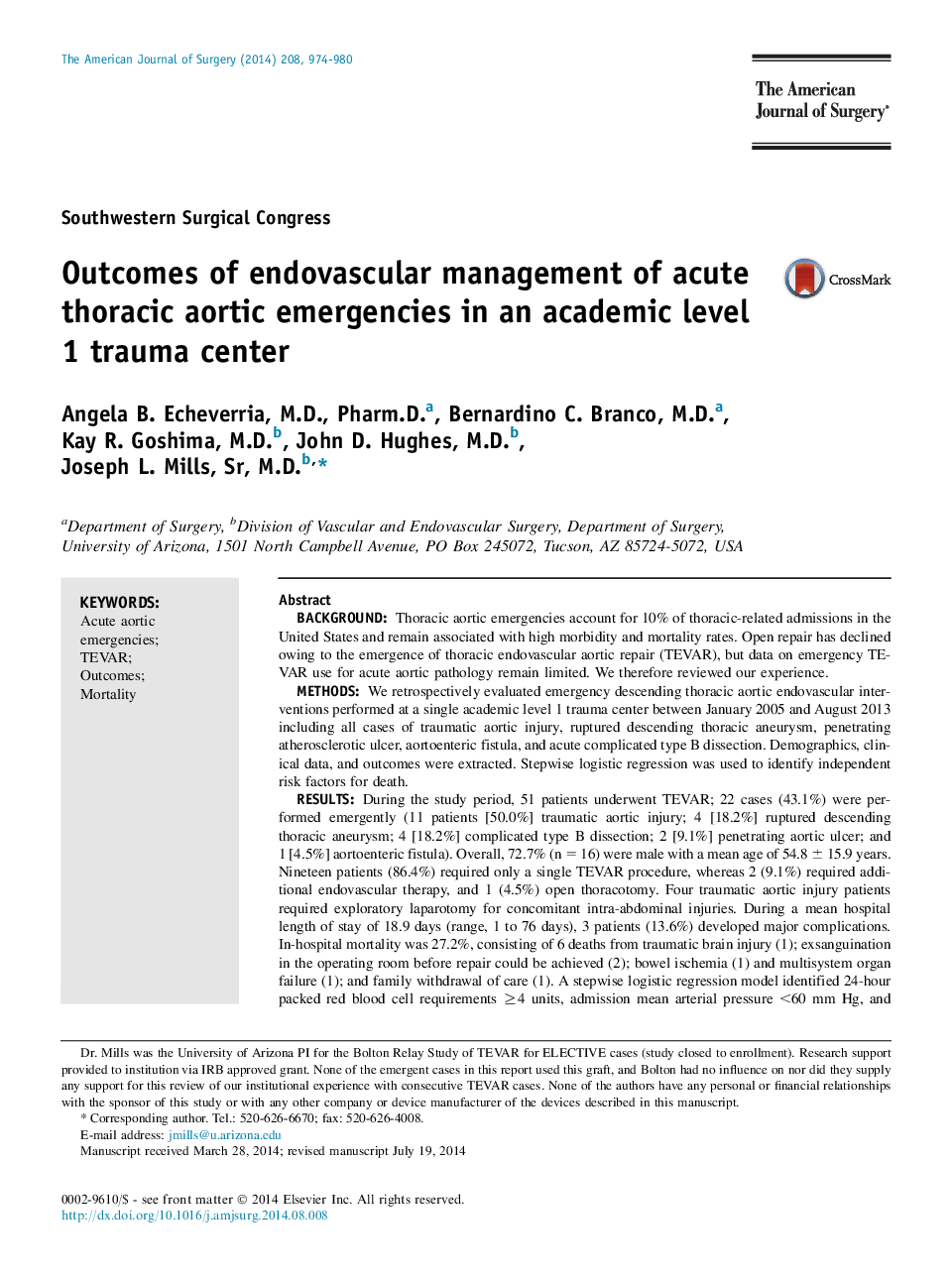| کد مقاله | کد نشریه | سال انتشار | مقاله انگلیسی | نسخه تمام متن |
|---|---|---|---|---|
| 4278399 | 1611500 | 2014 | 7 صفحه PDF | دانلود رایگان |
BackgroundThoracic aortic emergencies account for 10% of thoracic-related admissions in the United States and remain associated with high morbidity and mortality rates. Open repair has declined owing to the emergence of thoracic endovascular aortic repair (TEVAR), but data on emergency TEVAR use for acute aortic pathology remain limited. We therefore reviewed our experience.MethodsWe retrospectively evaluated emergency descending thoracic aortic endovascular interventions performed at a single academic level 1 trauma center between January 2005 and August 2013 including all cases of traumatic aortic injury, ruptured descending thoracic aneurysm, penetrating atherosclerotic ulcer, aortoenteric fistula, and acute complicated type B dissection. Demographics, clinical data, and outcomes were extracted. Stepwise logistic regression was used to identify independent risk factors for death.ResultsDuring the study period, 51 patients underwent TEVAR; 22 cases (43.1%) were performed emergently (11 patients [50.0%] traumatic aortic injury; 4 [18.2%] ruptured descending thoracic aneurysm; 4 [18.2%] complicated type B dissection; 2 [9.1%] penetrating aortic ulcer; and 1 [4.5%] aortoenteric fistula). Overall, 72.7% (n = 16) were male with a mean age of 54.8 ± 15.9 years. Nineteen patients (86.4%) required only a single TEVAR procedure, whereas 2 (9.1%) required additional endovascular therapy, and 1 (4.5%) open thoracotomy. Four traumatic aortic injury patients required exploratory laparotomy for concomitant intra-abdominal injuries. During a mean hospital length of stay of 18.9 days (range, 1 to 76 days), 3 patients (13.6%) developed major complications. In-hospital mortality was 27.2%, consisting of 6 deaths from traumatic brain injury (1); exsanguination in the operating room before repair could be achieved (2); bowel ischemia (1) and multisystem organ failure (1); and family withdrawal of care (1). A stepwise logistic regression model identified 24-hour packed red blood cell requirements ≥4 units, admission mean arterial pressure <60 mm Hg, and 24-hour fresh frozen plasma to packed red blood cell (pRBC) ratio <1:1.5 as independent risk factors for death in this cohort. During a mean follow-up of 369 days (range, 35 to 957 days), no subsequent major complications or deaths occurred. All patients underwent serial computed tomographic angiography surveillance, and no device-related problems were identified during intermediate follow-up.ConclusionsThoracic aortic emergencies remain challenging. Our experience in a moderate-volume center supports the utilization of TEVAR in the acute setting. Twenty-four-hour pRBC requirements ≥4 units, admission mean arterial pressure <60 mm Hg, and 24 hour fresh frozen plasma to pRBC ratio <1:1.5 were independently associated with death.
Journal: The American Journal of Surgery - Volume 208, Issue 6, December 2014, Pages 974–980
